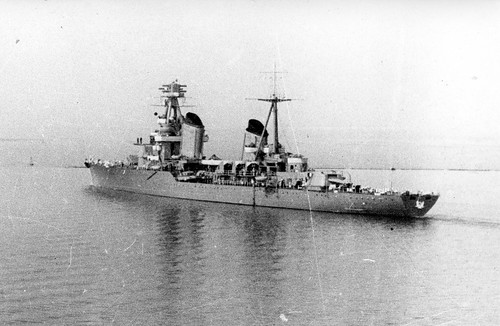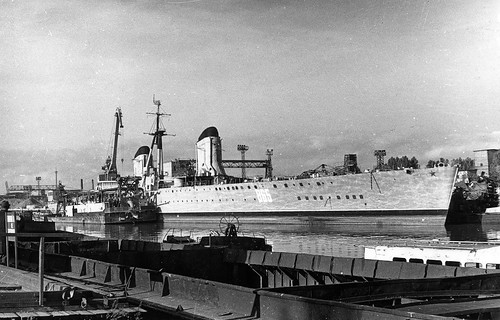 Protection of cruisers of project 26 included 50mm belt with 121m length and 3.4m height, covered by 50mm transverse bulkheads. 50mm main deck was connected with its upper edge. Turrets and barbettes from all directions were protected by 50mm plates, the conning tower had 150mm sides and 100mm roof. Steering gear compartment was covered by 20mm armour.
Protection of cruisers of project 26 included 50mm belt with 121m length and 3.4m height, covered by 50mm transverse bulkheads. 50mm main deck was connected with its upper edge. Turrets and barbettes from all directions were protected by 50mm plates, the conning tower had 150mm sides and 100mm roof. Steering gear compartment was covered by 20mm armour.Turrets were Italian-designed, placing all main guns in the common gun slide. Original armament consisted of 3 x 3 - 180mm, 6 x 1 - 100mm, 6 x 1 - 45mm guns, 4 x 1 - 12.7 MGs, 2 x 3 - 533 TT, 1 K-12 catapult, 2 KOR-1 seaplanes, 100 mines.
Kirov was commissioned into the Baltic Fleet in the autumn of 1938, but was still being worked on into early 1939. She sailed to Riga on 22 October when the Soviet Union began to occupy Latvia, continuing on to Liepāja the following day. During the Winter War, Kirov, escorted by the destroyers Smetlivyi and Stremitel'nyi, attempted to bombard Finnish coast defense guns at Russarö, 5 kilometres (3.1 mi) south of Hanko on 30 November. She only fired 35 rounds before she was damaged by a number of near misses and had to return to the Soviet naval base at Liepāja for repairs. She remained there for the rest of the Winter War and afterwards was under repair at Kronstadt from October 1940 to 21 May 1941.
 Based near Riga at the time of the German attack on the Soviet Union in June 1941, Kirov was trapped in the Gulf of Riga by the rapid enemy advance. She supported minelaying sorties by Soviet destroyers in the western half of the Irben Strait on the evenings of 24–25 and 26–27 June. Off-loading her fuel and ammunition to reduce her draft, she passed through the shallow Moon Sound Channel (between Muhu island and the Estonian mainland) with great difficulty, and managed to reach Tallinn by the end of June. Kirov provided gunfire support during the defense of Tallinn and served as the flagship of the evacuation fleet from Tallinn to Leningrad at the end of August 1941. For most of the rest of the war she was blockaded in Leningrad and Kronstadt by Axis minefields and could only provide gunfire support for the defenders during the Siege of Leningrad. She was damaged by a number of German air and artillery attacks, most seriously on 4–5 April 1942 when she was hit by three bombs and one 15-centimeter (5.9 in) shell that damaged all six 100 mm AA guns, the aft funnel, the mainmast, and killed 86 sailors and wounded 46. Repairs took two months during which her catapult was removed; a lighter pole mainmast was fitted and her anti-aircraft armament increased. After Leningrad was de-blocked in early 1944, Kirov remained there, and took no further part in the war except to provide gunfire support for the Soviet Vyborg–Petrozavodsk Offensive in mid–1944.
Based near Riga at the time of the German attack on the Soviet Union in June 1941, Kirov was trapped in the Gulf of Riga by the rapid enemy advance. She supported minelaying sorties by Soviet destroyers in the western half of the Irben Strait on the evenings of 24–25 and 26–27 June. Off-loading her fuel and ammunition to reduce her draft, she passed through the shallow Moon Sound Channel (between Muhu island and the Estonian mainland) with great difficulty, and managed to reach Tallinn by the end of June. Kirov provided gunfire support during the defense of Tallinn and served as the flagship of the evacuation fleet from Tallinn to Leningrad at the end of August 1941. For most of the rest of the war she was blockaded in Leningrad and Kronstadt by Axis minefields and could only provide gunfire support for the defenders during the Siege of Leningrad. She was damaged by a number of German air and artillery attacks, most seriously on 4–5 April 1942 when she was hit by three bombs and one 15-centimeter (5.9 in) shell that damaged all six 100 mm AA guns, the aft funnel, the mainmast, and killed 86 sailors and wounded 46. Repairs took two months during which her catapult was removed; a lighter pole mainmast was fitted and her anti-aircraft armament increased. After Leningrad was de-blocked in early 1944, Kirov remained there, and took no further part in the war except to provide gunfire support for the Soviet Vyborg–Petrozavodsk Offensive in mid–1944.Kirov was damaged by a German magnetic mine while leaving Kronstadt on 17 October 1945 and was under repair until 20 December 1946. She was refitted from November 1949 to April 1953, during which her machinery was completely overhauled and her radars, fire control systems and anti-aircraft guns were replaced by the latest Soviet systems. She participated in fleet maneuvers in the North Sea during January 1956.
 She was reclassified as a training cruiser, regularly visiting Poland and East Germany, on 2 August 1961 and sold for scrap on 22 February 1974. When Kirov was decommissioned, two gun turrets were installed in Saint Petersburg as a monument.
She was reclassified as a training cruiser, regularly visiting Poland and East Germany, on 2 August 1961 and sold for scrap on 22 February 1974. When Kirov was decommissioned, two gun turrets were installed in Saint Petersburg as a monument.



No comments:
Post a Comment